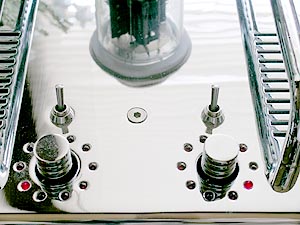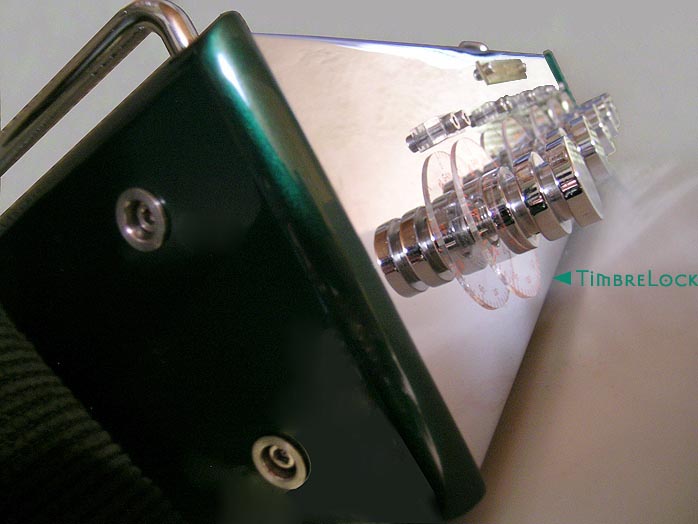|
|
|
|
This review page is supported in part by the sponsor whose ad is displayed above
|
|
 |
|
|
 |
|
 |
|
 |
|
|
|
Reviewer: Srajan Ebaen
Source: Zanden Audio Model 5000 MkIII DAC; Accustic Arts Drive-1; Audio Aero Prima [on review]; Einstein CDP [on review]
Preamp/Integrated: Bel Canto PRe2; Wyetech Labs Pearl [on loan]; Einstein integrated [on review]; Audiopax Model 5 [on review]
Amp: AUDIOPAX Model 88, Bel Canto eVo 4 Gen.II, Eastern Electric MiniMax
Speakers: Avantgarde Duo; Gallo Acoustics Reference 3; Green Mountain Audio Continuum 3 [on review]
Cables: Stealth Audio Varidig S/PDIF, Stealth Audio Indra (x2), Crystal Cable Reference speaker cable and power cords; ZCable Hurricane power cords on both conditioners
Stands: 2 x Grand Prix Audio Monaco four-tier
Powerline conditioning: BPT BP-3.5 Signature for source components; Walker Audio Velocitor
Sundry accessories: GPA Formula Carbon/Kevlar shelf for transport; GPA Apex footers underneath stand and speakers; Walker Audio SST on all connections; Walker Audio Vivid CD cleaner; Furutech RD-2 CD demagnetizer; WorldPower cryo'd Hubbell wall sockets; Musse Audio resonance dampers on DUO subs; Mapleshade 4" solid maple platform under BPT conditioner
Room size: 30' w x 18' d x 10' h [sloping ceiling] in long-wall setup in one half, with open adjoining living room for a total of ca.1000 squ.ft floor plan
Review Component Retail: $4,990 standard [black or silver aluminum case]; $5,490 Classic as shown [chromed brass case, Cardas RCAs]
|
|
|
|
|
|
 |
|
|
In certain circles, Eduardo de Lima's AUDIOPAX monoblocks have achieved semi-legendary status for their unique features and sonic prowess. The most famous of these features was cleverly dubbed TimbreLock to describe its effects. To understand how it works, envision each AUDIOPAX Model 88 monoblock as containing two fully discrete amplifier halves. Their slightly dissimilar output transformers are connected in series at the speaker output terminals. The bias current of the super-ultralinear wired KT88 pentodes can be adjusted individually and in offset with the other. This fine-tunes the amp's harmonic distortion behavior to the speakers being driven. Even skeptical Ken Kessler -- rightfully jaded by decades of hyperbolic press releases -- had to admit in surprise and appreciation that this TimbreLock worked exactly as advertised. Considering how long tube amps have been around, true inventions are rare and thus noteworthy. This established a |
|
 |
|
precedent of authentic inventiveness for AUDIOPAX. It became a self-imposed appointment with inspiration and destiny which the designer intended to honor for his planned preamplifier as well.
De Lima was thus in no hurry to introduce it. Though convinced -- and publicly acknowledged for it -- that his amplifiers truly broke new ground on more than one front, he was far less convinced that he had something equally radical to contribute to the global preamp scene. In a phone call from Brazil, he explained how he perceives preamps as falling into two general camps: Preamps for all seasons/amplifiers which precisely because of their jack-of-all-trades appeal are less than optimized for any given application; and specialized preamps that excel with certain amplifiers but, by definition, become less convincing with most others. In short, common appeal and compromised performance in one corner; highly specialized peak performance for the lucky few in the other. Somehow de Lima didn't like the odds this scenario presented to the end user. What about a third option - great performance no matter what?
|
|
| His preamp -- if he could just figure out a bloody way to do it -- would work optimally with any amplifier regardless of topology or output devices. Naturally, this mandated some type of adjustability or tuning feature. Alas, the designer was committed to a solid-state preamp for superior detail retrieval and inherently lower noise floor. How to implement a TimbreLock-derivative function without tubes? The reason why the Model 5's launch was delayed until now rests squarely on the implications this question presented. When inspiration finally hit, it still required more than a year to work out the complexities involved. How did de Lima finally succeed with his ambitions? The core idea derives from a common observation in recording studios. Their multiple series-connected gain stages between microphone and DAT/CDR/DVD recorder allow independent adjustments. Any recording engineer worth his salt knows how different combinations of gain settings alter the sonic outcome in |
|
|
|
|
 |
|
very significant ways to become a sophisticated voicing option during the recording process. What if the AUDIOPAX preamp-to-be sported two adjustable gain facilities, one the master volume control, the other a preamplifier/amplifier matching device? What de Lima envisioned had nothing to do with common input sensitivity pots that avoid overload scenarios. His scheme aims at THD optimization between preamp and amp instead - a transistorized version of the Model 88s' famous TimbreLock facility.
Reportedly, the first preamplifier prototype behaved exactly as modeling predicted. It convinced the Brazilian designer that his Model 5 project was finally a go. But it would require endless testing sessions with a large number of amplifiers to center the adjustment range on the most simpatico median value and to learn how large a range to incorporate and what its incremental steps should be. De Lima knew all along that the Model 5 would have choke-filtered outputs and a dual-mono outboard power supply. Still, implementation and elimination of noise in the circuit again took a lot longer than having those brilliant brain farts in the first place. Dubbed "the world's best preamplifier" by the Editor of Brazil's preeminent magazine -- who awarded the Model 5 an extra half star beyond the highest possible rating and subsequently purchased the review model, replacing a $15,000 Jeff Rowland battery-powered unit to drive a Danish $35,000 Sphinx amplifier and upper-end Dynaudio speakers -- 6moons this time isn't scooping an AUDIOPAX product launch. In fact, not only did the Brazilians beat us to it (fitting seeing how their soccer team kicked our collective Ärsche a long time ago), but Roy Gregory of HiFi+ has and so have the Norwegians.
Being fourth in line on this occasion, we shall determine whether our experienced colleague's findings will be repeatable in our own setup. If they are, it would prove that the preamp's claimed morphability of excellence -- for any conceivable solid-state and tube amp -- has acquitted itself again with an additional number of whatever amplifiers yours truly can unearth during the review period. But first, the obligatory tour of the device under consideration.
|
|
 |
|
|
The business quarters are simplicity itself, offering 5 single-ended inputs, one rec-out and two single-ended pre-outs. One 4- and one 5-pin DIN socket connect twin captured umbilicals on the external power supply. One central toggle selects between hi/low gain (23/12dB). Around front, things get a bit more unusual with the abundance of five rotary controls that do not include a balance control but dual-mono TimbreLock controls with precise hairline settings in 50 increments [below], one central master volume in again 50 steps, one rec-out control assigning one of the five inputs to those record sockets and the source selector control. Automotive lacquer cheeks, chromed brass front/top [for the Classic version as shown] and top-mounted handles mimic the Model 88 aesthetic.
|
|
 |
|
|
|
Dimensions are 17.5" W x 6" H x 10" D for the main unit, 9" W x 3" H x 7.5" D for the plastic-cased outboard supply. Respective weights are 14 and 6 lbs, the umbilicals measuring 52" long to allow for plenty of physical separation between both units. As with the Model 88s that have been my constant companions since their debut, the TimbreLock adjustments are set'n'forget one-time affairs unless one changes loudspeakers (Model 88) or amplifiers (Model 5).
Our Brazilian colleague in the press has gone as far as to document settings for different cables to suggest that this preamp feature is keen enough to account for wire-induced parameters. Needless to say, your German team is now honor-bound to do the same. Gracias, Fernando -:)... |
|
 |
|
In fact, to truly go to town, the Audiopax Model 5 will go mano-i-mano with the Wyetech Labs Pearl (valve) and the Bel Canto Design PRe2 (transistor) to get specific about into which camp -- if either -- the Brazilian contender falls. Or perhaps it'll slide in-between somewhere? The forthcoming review will thus be a tryptich of individual model introductions like today's. Once the Bel Canto and Wyetech installments are published, they'll eventually converge into a joint performance commentary about them all together. After all, as no man is an island, no preamp can be adjugded in limbo, especially one whose design objective is this unique. Stay tuned. For those wondering why no images of the innards, I'm refraining from my usual habit because AUDIOPAX is currently applying for numerous patents. Doesn't it strike you as just a bit radical that a designer who's made a name for himself with tube amplifiers would follow them up with a solid-state -- and inverting -- preamp? There's likely more under its hood than he's willing to tell for now but I shan't be the one to prematurely divulge his secrets ... |
|
|
|
 |
|
|
 |
|
|
|
|
|
|
|
|
|
|
|
|
|